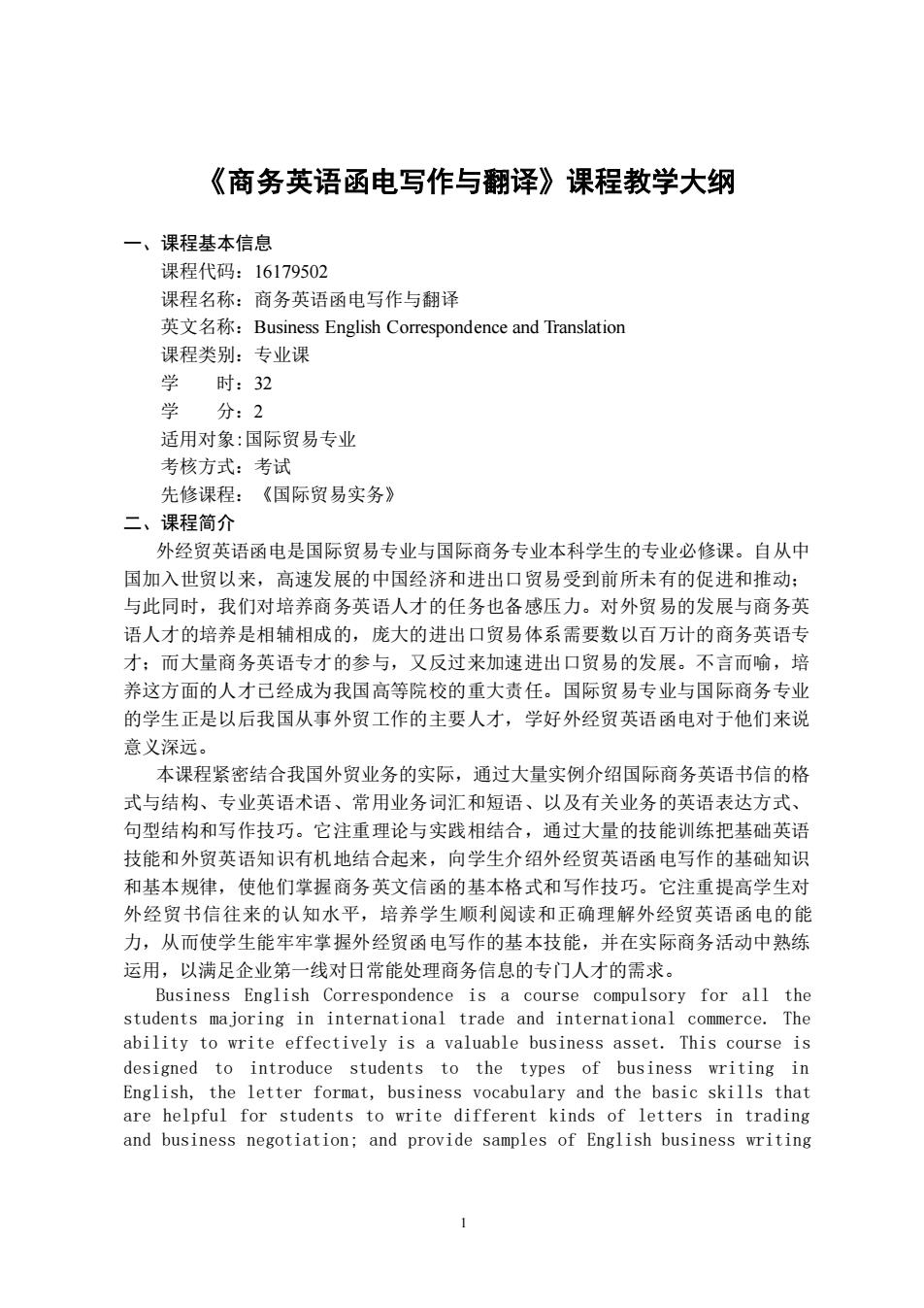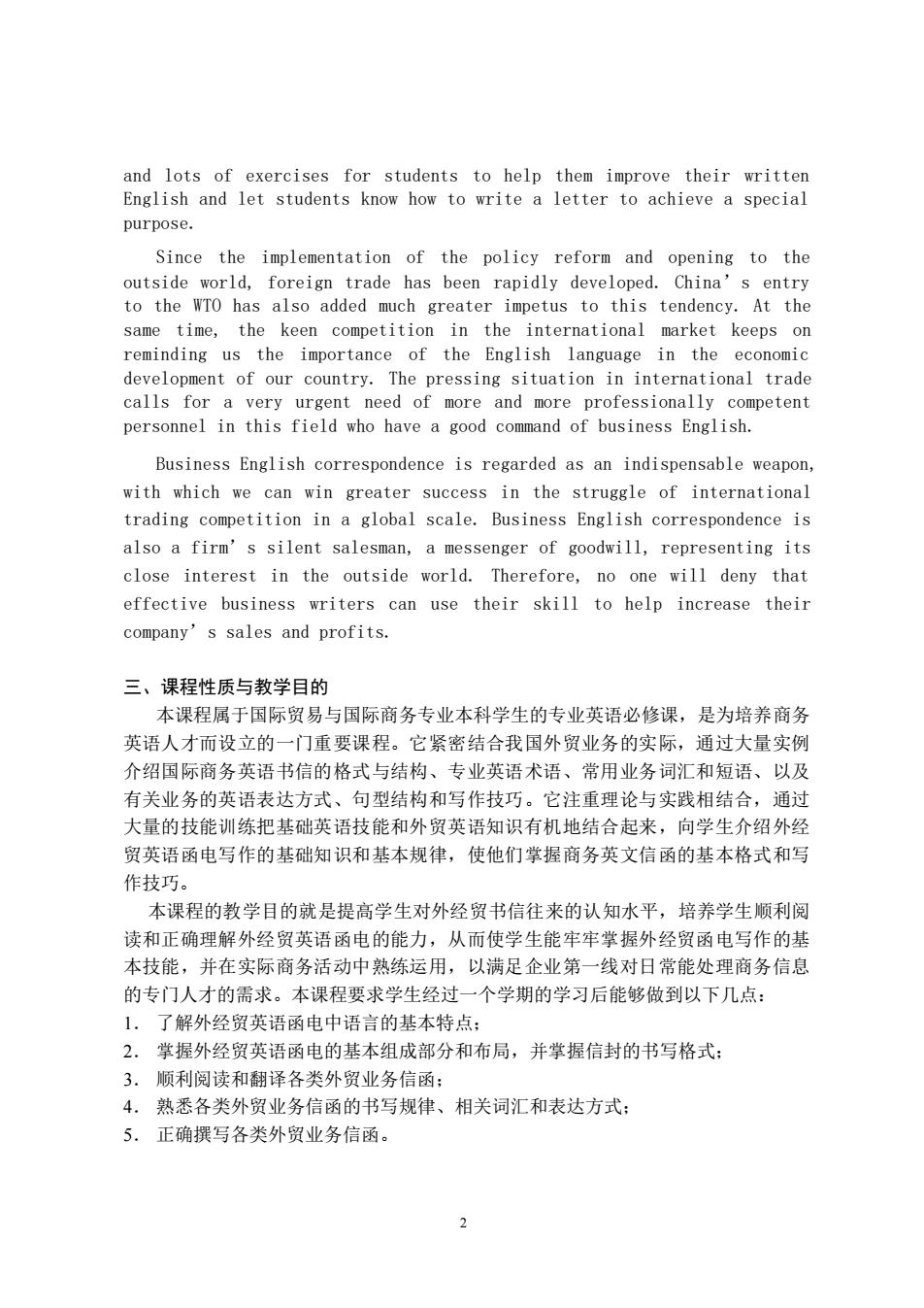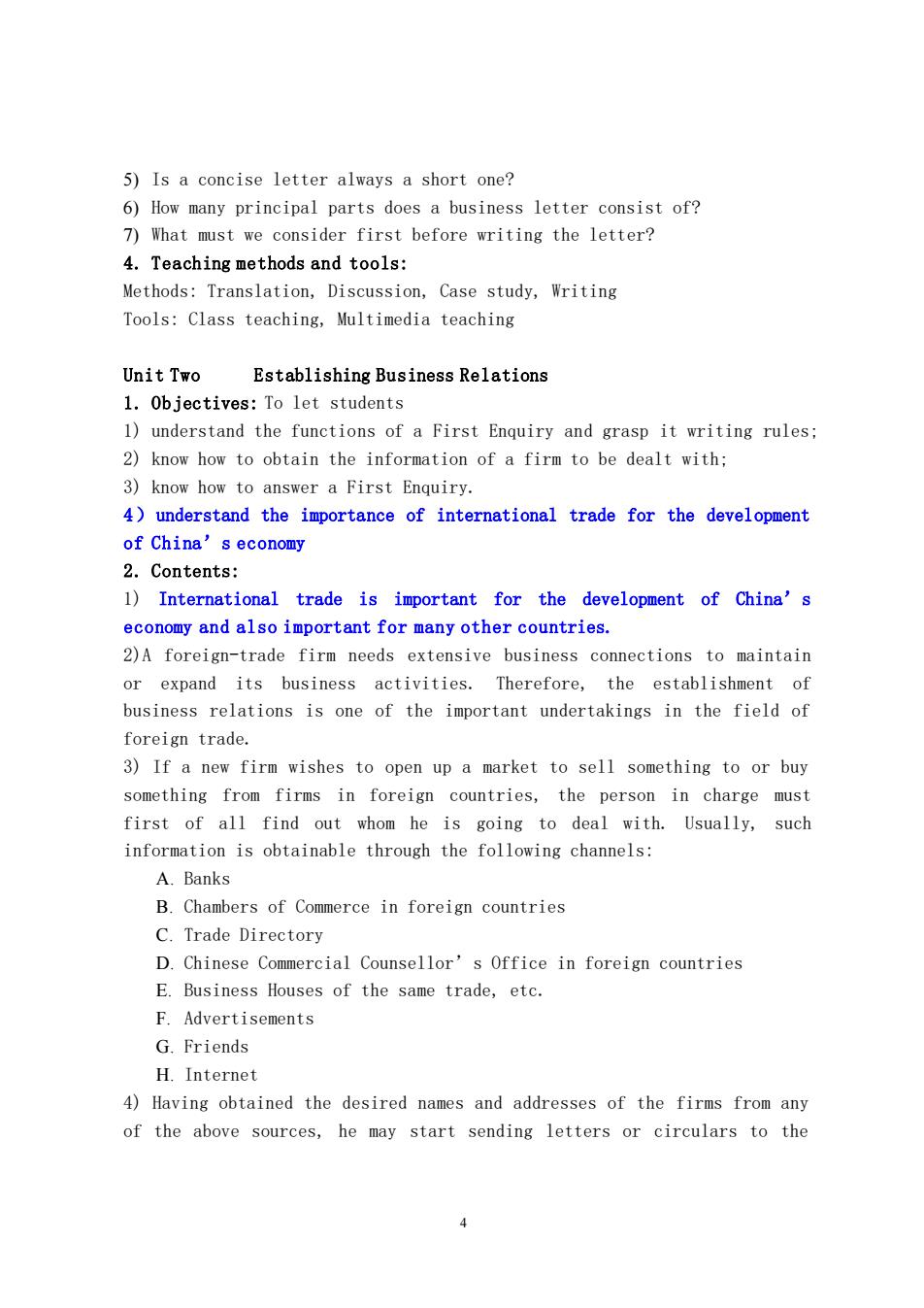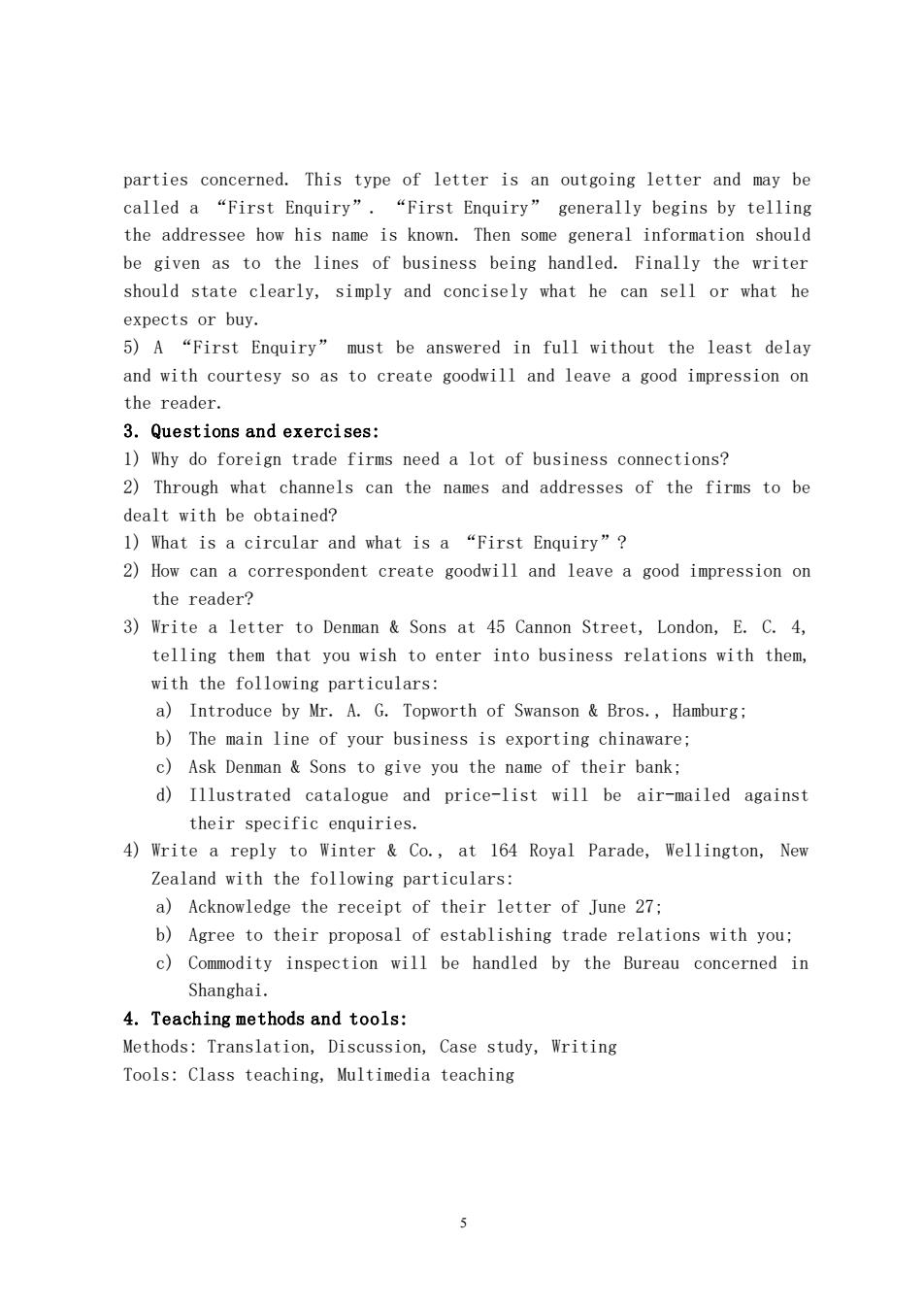
《商务英语函电写作与翻译》课程教学大纲 一、课程基本信息 课程代码:16179502 课程名称:商务英语函电写作与翻译 英文名称:Business English Correspondence and Translation 课程类别:专业课 学时:32 学分:2 适用对象:国际贸易专业 考核方式:考试 先修课程:《国际贸易实务》 二、课程简介 外经贸英语函电是国际贸易专业与国际商务专业本科学生的专业必修课。自从中 国加入世贸以来,高速发展的中国经济和进出口贸易受到前所未有的促进和推动: 与此同时,我们对培养商务英语人才的任务也备感压力。对外贸易的发展与商务英 语人才的培养是相辅相成的,庞大的进出口贸易体系需要数以百万计的商务英语专 才:而大量商务英语专才的参与,又反过来加速进出口贸易的发展。不言而喻,培 养这方面的人才己经成为我国高等院校的重大责任。国际贸易专业与国际商务专业 的学生正是以后我国从事外贸工作的主要人才,学好外经贸英语函电对于他们来说 意义深远。 本课程紧密结合我国外贸业务的实际,通过大量实例介绍国际商务英语书信的格 式与结构、专业英语术语、常用业务词汇和短语、以及有关业务的英语表达方式、 句型结构和写作技巧。它注重理论与实践相结合,通过大量的技能训练把基础英语 技能和外贸英语知识有机地结合起来,向学生介绍外经贸英语函电写作的基础知识 和基本规律,使他们掌握商务英文信函的基本格式和写作技巧。它注重提高学生对 外经贸书信往来的认知水平,培养学生顺利阅读和正确理解外经贸英语函电的能 力,从而使学生能牢牢掌握外经贸函电写作的基本技能,并在实际商务活动中熟练 运用,以满足企业第一线对日常能处理商务信息的专门人才的需求。 Business English Correspondence is a course compulsory for all the students majoring in international trade and international commerce.The ability to write effectively is a valuable business asset.This course is designed to introduce students to the types of business writing in English, the lette format,bu rocabulary and the basic skills tha are helpful for students to write different kinds of letters in trading and business negotiation;and provide samples of English business writing
1 《商务英语函电写作与翻译》课程教学大纲 一、课程基本信息 课程代码:16179502 课程名称:商务英语函电写作与翻译 英文名称:Business English Correspondence and Translation 课程类别:专业课 学 时:32 学 分:2 适用对象:国际贸易专业 考核方式:考试 先修课程:《国际贸易实务》 二、课程简介 外经贸英语函电是国际贸易专业与国际商务专业本科学生的专业必修课。自从中 国加入世贸以来,高速发展的中国经济和进出口贸易受到前所未有的促进和推动; 与此同时,我们对培养商务英语人才的任务也备感压力。对外贸易的发展与商务英 语人才的培养是相辅相成的,庞大的进出口贸易体系需要数以百万计的商务英语专 才;而大量商务英语专才的参与,又反过来加速进出口贸易的发展。不言而喻,培 养这方面的人才已经成为我国高等院校的重大责任。国际贸易专业与国际商务专业 的学生正是以后我国从事外贸工作的主要人才,学好外经贸英语函电对于他们来说 意义深远。 本课程紧密结合我国外贸业务的实际,通过大量实例介绍国际商务英语书信的格 式与结构、专业英语术语、常用业务词汇和短语、以及有关业务的英语表达方式、 句型结构和写作技巧。它注重理论与实践相结合,通过大量的技能训练把基础英语 技能和外贸英语知识有机地结合起来,向学生介绍外经贸英语函电写作的基础知识 和基本规律,使他们掌握商务英文信函的基本格式和写作技巧。它注重提高学生对 外经贸书信往来的认知水平,培养学生顺利阅读和正确理解外经贸英语函电的能 力,从而使学生能牢牢掌握外经贸函电写作的基本技能,并在实际商务活动中熟练 运用,以满足企业第一线对日常能处理商务信息的专门人才的需求。 Business English Correspondence is a course compulsory for all the students majoring in international trade and international commerce. The ability to write effectively is a valuable business asset. This course is designed to introduce students to the types of business writing in English, the letter format, business vocabulary and the basic skills that are helpful for students to write different kinds of letters in trading and business negotiation; and provide samples of English business writing

and lots of exercises for students to help them improve their written English and let students know how to write a letter to achieve a special purpose. Since the implementation of the policy reform and opening to the outside ord foreign trade has been ahinant to the wTo has also added much greater i same time, the keen competition in the international market keeps on reminding us the importance of the English language in the economic development of our country.The pressing situation in international trade calls for a very urgent need of more and more professionally competent personnel in this field who have a good command of business English. Business English correspondence is regarded as an indispensable weapon with which we can win greater success in the struggle of international trading competition in a global scale.Business English correspondence is also a firm's silent salesman,a messenger of goodwill,representing its close interest in the outside world.Therefore,no one will deny that effective business writers can use their skill to help increase their company's sales and profits. 三、课程性质与教学目的 本课程属于国际贸易与国际商务专业本科学生的专业英语必修课,是为培养商务 英语人才而设立的一门重要课程。它紧密结合我国外贸业务的实际,通过大量实例 介绍国际商务英语书信的格式与结构、专业英语术语、常用业务词汇和短语、以及 有关业务的英语表达方式、句型结构和写作技巧。它注重理论与实践相结合,通过 大量的技能训练把基础英语技能和外贸英语知识有机地结合起来,向学生介绍外经 贸英语函电写作的基础知识和基本规律,使他们掌握商务英文信函的基本格式和写 作技巧。 本课程的教学目的就是提高学生对外经贸书信往来的认知水平,培养学生顺利阅 读和正确理解外经贸英语函电的能力,从而使学生能牢牢掌握外经贸函电写作的基 本技能,并在实际商务活动中熟练运用,以满足企业第一线对日常能处理商务信息 的专门人才的需求。本课程要求学生经过一个学期的学习后能够做到以下几点: 1,了解外经贸英语函电中语言的基本特点: 2.掌握外经贸英语函电的基本组成部分和布局,并掌握信封的书写格式: 3.顺利阅读和翻译各类外贸业务信函: 4.熟悉各类外贸业务信函的书写规律、相关词汇和表达方式: 5.正确撰写各类外贸业务信函
2 and lots of exercises for students to help them improve their written English and let students know how to write a letter to achieve a special purpose. Since the implementation of the policy reform and opening to the outside world, foreign trade has been rapidly developed. China’s entry to the WTO has also added much greater impetus to this tendency. At the same time, the keen competition in the international market keeps on reminding us the importance of the English language in the economic development of our country. The pressing situation in international trade calls for a very urgent need of more and more professionally competent personnel in this field who have a good command of business English. Business English correspondence is regarded as an indispensable weapon, with which we can win greater success in the struggle of international trading competition in a global scale. Business English correspondence is also a firm’s silent salesman, a messenger of goodwill, representing its close interest in the outside world. Therefore, no one will deny that effective business writers can use their skill to help increase their company’s sales and profits. 三、课程性质与教学目的 本课程属于国际贸易与国际商务专业本科学生的专业英语必修课,是为培养商务 英语人才而设立的一门重要课程。它紧密结合我国外贸业务的实际,通过大量实例 介绍国际商务英语书信的格式与结构、专业英语术语、常用业务词汇和短语、以及 有关业务的英语表达方式、句型结构和写作技巧。它注重理论与实践相结合,通过 大量的技能训练把基础英语技能和外贸英语知识有机地结合起来,向学生介绍外经 贸英语函电写作的基础知识和基本规律,使他们掌握商务英文信函的基本格式和写 作技巧。 本课程的教学目的就是提高学生对外经贸书信往来的认知水平,培养学生顺利阅 读和正确理解外经贸英语函电的能力,从而使学生能牢牢掌握外经贸函电写作的基 本技能,并在实际商务活动中熟练运用,以满足企业第一线对日常能处理商务信息 的专门人才的需求。本课程要求学生经过一个学期的学习后能够做到以下几点: 1. 了解外经贸英语函电中语言的基本特点; 2. 掌握外经贸英语函电的基本组成部分和布局,并掌握信封的书写格式; 3. 顺利阅读和翻译各类外贸业务信函; 4. 熟悉各类外贸业务信函的书写规律、相关词汇和表达方式; 5. 正确撰写各类外贸业务信函

四、教学内容及要求 Unit One:Layout of Business Letters 1.Objectives:To let students 1)understand the functions and the essential qualities of business letters: 2)get familiar with the general layout of business letters and the tendency of business letter-writing. 3)Understand the differences of layout between Chinese letters and English letters,cultivating the value of Chinese traditional culture 2.Contents: Part One:Functions and Essentials of Business Letter-writing 1)The functions of a business letter are (a)to ask for or to convey information;(b)to make or accept an offer:(c)to deal with matters concerning negotiation of business. 2)There are certain essential qualities of business letters,which can be summed up in the Three C's,i.e.(a)Clearness;(b)Conciseness; (c)Courtesy.In some other books,more C's are added,such as Consideration,Concreteness,Correctness and Completeness. Part Two:Layout of Business Letters 1)Speaking of format,there are two main patterns in use at present.One is full block form:the other is modified block form with indented paragraphs. 2)The modern business letter is nearly always typed.It consists of seven principle parts:(a)the letter-head;(b)the date;(c)the inside name and address:(d)the salutation;(e)the message:(f)the complementary close and (g)the writer's signature and official position. 3.Questions and exercises: 1)What are the functions of a business letter? 2)What are the three C's? 3)What will be the result if a letter is ambiguous?How can this be avoided? 4)Do we use complicated words in our letters?
3 四、教学内容及要求 Unit One: Layout of Business Letters 1. Objectives: To let students 1) understand the functions and the essential qualities of business letters; 2) get familiar with the general layout of business letters and the tendency of business letter-writing. 3) Understand the differences of layout between Chinese letters and English letters, cultivating the value of Chinese traditional culture 2. Contents: Part One: Functions and Essentials of Business Letter-writing 1) The functions of a business letter are (a) to ask for or to convey information; (b) to make or accept an offer; (c) to deal with matters concerning negotiation of business. 2) There are certain essential qualities of business letters, which can be summed up in the Three C’s, i.e. (a) Clearness; (b) Conciseness; (c) Courtesy. In some other books, more C’s are added, such as Consideration, Concreteness, Correctness and Completeness. Part Two: Layout of Business Letters 1) Speaking of format, there are two main patterns in use at present. One is full block form; the other is modified block form with indented paragraphs. 2) The modern business letter is nearly always typed. It consists of seven principle parts: (a) the letter-head; (b) the date; (c) the inside name and address; (d) the salutation; (e) the message; (f) the complementary close and (g) the writer’s signature and official position. 3. Questions and exercises: 1) What are the functions of a business letter? 2) What are the three C’s? 3) What will be the result if a letter is ambiguous? How can this be avoided? 4) Do we use complicated words in our letters?

5)Is a concise letter always a short one? 6)How many principal parts does a business letter consist of? 7)What must we consider first before writing the letter? 4.Teaching methods and tools: Methods:Translation,Discussion,Case study,Writing Tools:Class teaching,Multimedia teaching Unit Two Establishing Business Relations 1.Objectives:To let students 1)understand the functions of a First Enquiry and grasp it writing rules; 2)know how to obtain the information of a firm to be dealt with: 3)know how to answer a First Enquiry. 4)understand the importance of international trade for the development of China's economy 2.Contents: 1)International trade is important for the development of China's economy and also important for many other countries. 2)A foreign-trade firm needs extensive business connections to maintain or expand its business activities.Therefore,the establishment of business relations is one of the important undertakings in the field of foreign trade. 3)If a new firm wishes to open up a market to sell something to or buy something from firms in foreign countries,the person in charge must first of all find out whom he is going to deal with.Usually,such information is obtainable through the following channels: A Banks B.Chambers of Commerce in foreign countries C.Trade Directory D.Chinese Commercial Counsellor's Office in foreign countries E.Business Houses of the same trade,etc. F.Advertisements G.Friends H.Internet 4)Having obtained the desired names and addresses of the firms from any of the above sources,he may start sending letters or circulars to the
4 5) Is a concise letter always a short one? 6) How many principal parts does a business letter consist of? 7) What must we consider first before writing the letter? 4. Teaching methods and tools: Methods: Translation, Discussion, Case study, Writing Tools: Class teaching, Multimedia teaching Unit Two Establishing Business Relations 1. Objectives: To let students 1) understand the functions of a First Enquiry and grasp it writing rules; 2) know how to obtain the information of a firm to be dealt with; 3) know how to answer a First Enquiry. 4)understand the importance of international trade for the development of China’s economy 2. Contents: 1) International trade is important for the development of China’s economy and also important for many other countries. 2)A foreign-trade firm needs extensive business connections to maintain or expand its business activities. Therefore, the establishment of business relations is one of the important undertakings in the field of foreign trade. 3) If a new firm wishes to open up a market to sell something to or buy something from firms in foreign countries, the person in charge must first of all find out whom he is going to deal with. Usually, such information is obtainable through the following channels: A. Banks B. Chambers of Commerce in foreign countries C. Trade Directory D. Chinese Commercial Counsellor’s Office in foreign countries E. Business Houses of the same trade, etc. F. Advertisements G. Friends H. Internet 4) Having obtained the desired names and addresses of the firms from any of the above sources, he may start sending letters or circulars to the

parties concerned.This type of letter is an outgoing letter and may be called a“First Enquiry”.“First Enquiry”generally begins by telling the addressee how his name is known.Then some general information should be given as to the lines of business being handled.Finally the writer should state clearly.simply and concisely what he can sell or what he expects or buy. 5)A "First Enquiry"must be answered in full without the least delay and with courtesy so as to create goodwill and leave a good impression on the reader. 3.Questions and exercises: 1)Why do foreign trade firms need a lot of business connections? 2)Through what channels can the names and addresses of the firms to be dealt with be obtained? 1)What is a circular and what is a "First Enquiry"? 2)How can a correspondent create goodwill and leave a good impression on the reader? 3)Write a letter to Denman Sons at 45 Cannon Street,London,E.C.4, telling them that you wish to enter into business relations with them, with the following particulars: a)Introduce by Mr.A.G.Topworth of Swanson Bros.,Hamburg: b)The main line of your business is exporting chinaware; c)Ask Denman Sons to give you the name of their bank: d)Illustrated catalogue and price-list will be air-mailed against their specific enquiries. 4)Write a reply to Winter Co.,at 164 Royal Parade,Wellington,New Zealand with the following particulars: a)Acknowledge the receipt of their letter of June 27; b)Agree to their proposal of establishing trade relations with you c)Commodity inspection will be handled by the Bureau concerned in Shanghai. 4.Teaching methods and tools: Methods:Translation,Discussion,Case study,Writing Tools:Class teaching,Multimedia teaching
5 parties concerned. This type of letter is an outgoing letter and may be called a “First Enquiry”. “First Enquiry” generally begins by telling the addressee how his name is known. Then some general information should be given as to the lines of business being handled. Finally the writer should state clearly, simply and concisely what he can sell or what he expects or buy. 5) A “First Enquiry” must be answered in full without the least delay and with courtesy so as to create goodwill and leave a good impression on the reader. 3. Questions and exercises: 1) Why do foreign trade firms need a lot of business connections? 2) Through what channels can the names and addresses of the firms to be dealt with be obtained? 1) What is a circular and what is a “First Enquiry”? 2) How can a correspondent create goodwill and leave a good impression on the reader? 3) Write a letter to Denman & Sons at 45 Cannon Street, London, E. C. 4, telling them that you wish to enter into business relations with them, with the following particulars: a) Introduce by Mr. A. G. Topworth of Swanson & Bros., Hamburg; b) The main line of your business is exporting chinaware; c) Ask Denman & Sons to give you the name of their bank; d) Illustrated catalogue and price-list will be air-mailed against their specific enquiries. 4) Write a reply to Winter & Co., at 164 Royal Parade, Wellington, New Zealand with the following particulars: a) Acknowledge the receipt of their letter of June 27; b) Agree to their proposal of establishing trade relations with you; c) Commodity inspection will be handled by the Bureau concerned in Shanghai. 4. Teaching methods and tools: Methods: Translation, Discussion, Case study, Writing Tools: Class teaching, Multimedia teaching